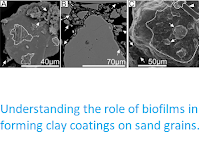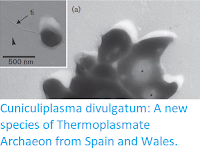Microbial mats are thought to be the oldest biological communities on Earth, with a fossil record that dates back at least 3.5 billion years. Today these communities rend to be found in extreme environments where other organisms cannot thrive, such as hot springs or hypersaline lakes. The Baikal Rift Zone in southern Siberia is home to a number of hot spring systems with unusually alkaline waters, which are likely to be host to unique communities of mat-forming microbes, but which are relatively understudied.
In a paper published in the journal BMC Evolutionary Biology on 28 December 2017, Alexey Sergeevich Rozanov and Alla Victorovna Bryanskaya of the Institute of Cytology and Genetics of the Siberian Branch of the Russian Academy of Sciences, Timofey Vladimirovich Ivanisenko, also of the Institute of Cytology and Genetics of the Siberian Branch of the Russian Academy of Sciences, and of the Novosibirsk State University, and Tatyana Konstantinovna Malup and Sergey Evgenievich Peltek, again of the Institute of Cytology and Genetics of the Siberian Branch of the Russian Academy of Sciences, present the results of a study of the biodiversity of microbial mats around the Garga Hot Spring in the Barguzin Valley of the Republic of Buryatia in southern Siberia, which has the most alkaline known waters of any hot spring in the Baikal Rift Zone, with pH values of between 8.0 and 9.0.
(a) Eastern Siberia; (b, Eastern Baikal, Barguzin Valley, satellite photo. Red cross marks the location of the Garga hot spring (54°19′3.72″N, 110°59′38.4″E). Rozanov et al. (2017).
Rozanov et al sampled waters originating from the spring at four points. The first of there was close to the spring itself, with waters at temperatures in excess of 74°C, where there was a simple biofilm of white material was present. The second was located in a stream running from the spring towards the Barguzin River, where the waters were about 70°C, and a thicker biofilm with three distinct layers had developed. The upper two layers were yellowish, with the upper being dense and about 2 mm thick and the lower being thinner and about 2 cm. The bottom layer was about 1 cm thick, white, gelatinous and adhered to the substrate. The third point was further downstream, where the temperature had fallen to 55°C. Here the mat still had three layers, with the top layer being yellowish green and about 2 mm thick, the middle layer being membranous, gelatinous and whitish-green and about 2 cm thick, while the bottom layer was again 1 cm thick, gelatinous and white. The final point was further downstream, where the temperature had fallen to 45°C. Here there were again three layers, with the upper two layers being apparently identical to those at the third site, while the bottom layer as thinner, about 3-5 mm, and 'skin coloured'.
The sample taken from the first location contained a significant proportion of Archaeans (Prokaryotic micro-organisms resembling Bacteria, but only distantly related to them, and more closely related to Eukaryotes, about 20% of the sample, the highest proportion found at any site in the Baikal Rift Zone to date. Many of these belonged to the Crenarchaeota, a group widely associated with hot springs, with about 7.9% of the sample closely related to Thermopro teusuzonensis, a species isolated from acid hot springs on the Kamchatka Peninsula, and Vulcanis aetasouniana, a species from acidic springs in Japan. However, the sample also contained other, non-Crenarchaeote, Archaeans, with no apparent close relationships to any other described species.
The remaining three sites had essentially similar structures, with an upper layer dominated by Cyanobacteria (filament-forming photosynthetic Bacteria) of the genera Leptolyngbya, Synechococcus and Nostoc, all associated with hot springs in a variety of other locations around the world. The second layer contained lower numbers of Cyanobacteria, though they were still present, along with heterotrophic Bacteria (Bacteria that gain nutrition by consuming other Bacteria), principally Proteobacteria and Actinobacteria. The lowermost layer was anearobic and dominated by saprotrphic Bacteria such as Clostridia, obtain nutrition by breaking down organic material externally.
See also...
Microbial mats of the Garga hot spring. (a) Microbial mat of the upper reaches of the spring; red circle, second sampling point. (b) Microbial mat of the middle reaches; red circle, third sampling point. (c) Layers of the third sample. (d) Sampling scheme. Rozanov et al. (2017).
The sample taken from the first location contained a significant proportion of Archaeans (Prokaryotic micro-organisms resembling Bacteria, but only distantly related to them, and more closely related to Eukaryotes, about 20% of the sample, the highest proportion found at any site in the Baikal Rift Zone to date. Many of these belonged to the Crenarchaeota, a group widely associated with hot springs, with about 7.9% of the sample closely related to Thermopro teusuzonensis, a species isolated from acid hot springs on the Kamchatka Peninsula, and Vulcanis aetasouniana, a species from acidic springs in Japan. However, the sample also contained other, non-Crenarchaeote, Archaeans, with no apparent close relationships to any other described species.
The remaining three sites had essentially similar structures, with an upper layer dominated by Cyanobacteria (filament-forming photosynthetic Bacteria) of the genera Leptolyngbya, Synechococcus and Nostoc, all associated with hot springs in a variety of other locations around the world. The second layer contained lower numbers of Cyanobacteria, though they were still present, along with heterotrophic Bacteria (Bacteria that gain nutrition by consuming other Bacteria), principally Proteobacteria and Actinobacteria. The lowermost layer was anearobic and dominated by saprotrphic Bacteria such as Clostridia, obtain nutrition by breaking down organic material externally.
See also...
Follow Sciency Thoughts on
Facebook.








